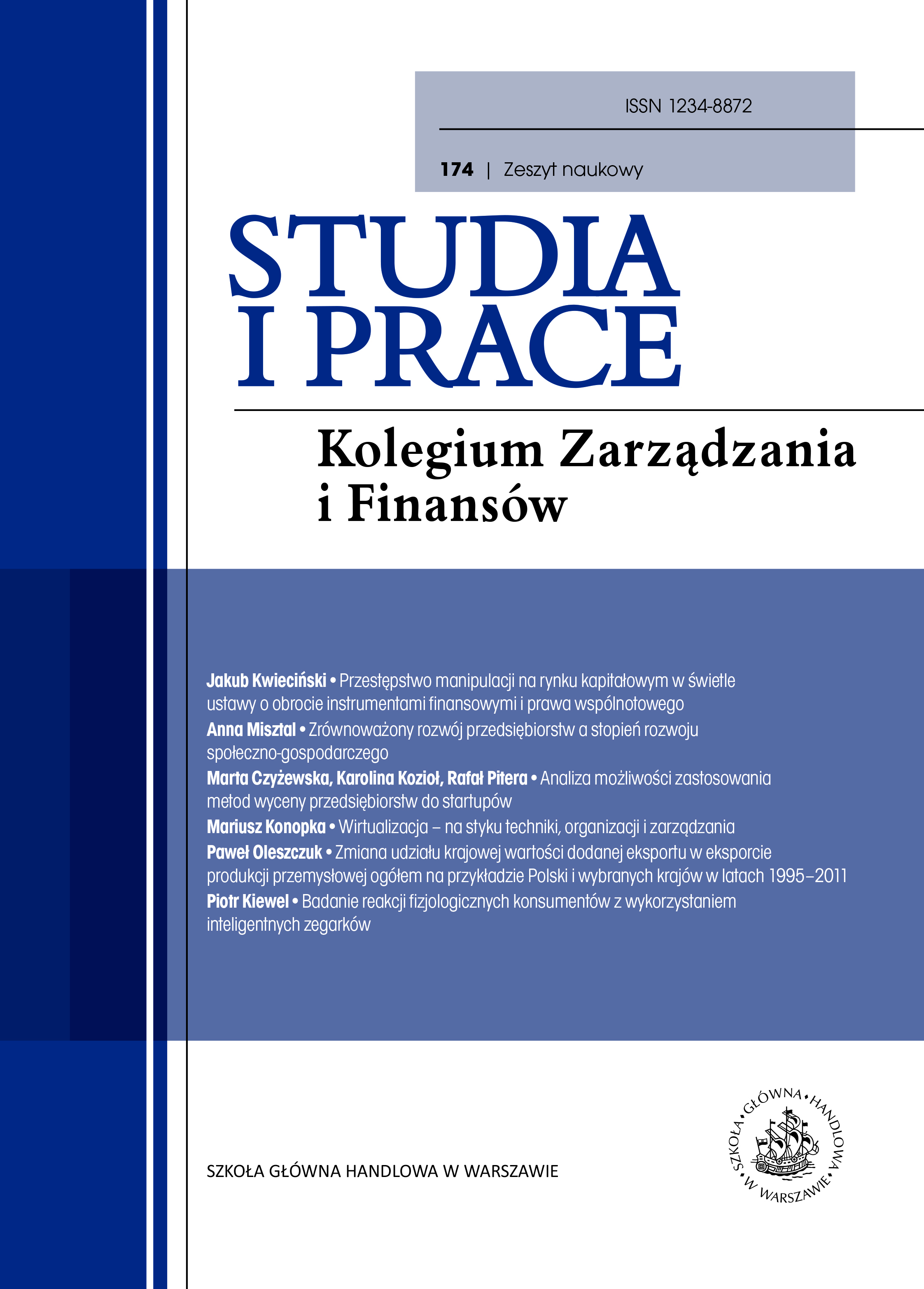Badanie reakcji fizjologicznych konsumentów z wykorzystaniem inteligentnych zegarków
DOI:
https://doi.org/10.33119/SIP.2019.174.6Słowa kluczowe:
Apple Pay, Apple Watch, emocje, impuls, podejmowanie decyzji, psychologia, puls, smart zegarkiAbstrakt
Według badań przeprowadzonych przez T. Tyszkę, ponad 2/3 zakupów nie jest wcześniej zaplanowanych. Stanowi to szansę dla sprzedających do nakłonienia swoich potencjalnych klientów do zakupu ich produktów. Kluczowym aspektem staje się właściwa segmentacja klientów, wzbogacona o nowe, dotąd nieprzetwarzane dane. Drgania, tętno, liczba spalonych kalorii to tylko niektóre dane, które są zbierane przez smartwatche. Sprzedaż inteligentnych zegarków oraz opasek wzrosła o ponad 10% w skali roku. Aby zaspokoić rosnący popyt, powstają urządzenia zbierające informacje o funkcjonowaniu ludzkiego organizmu. Urządzenia ubieralne oraz smartfony zyskują nowe funkcjonalności i w połączeniu z instytucjami finansowymi dają możliwość dokonywania nimi płatności. Połączenie danych transakcyjnych z podstawowymi danymi o zachowaniu organizmu przed podjęciem decyzji o zakupie
daje możliwość lepszego zrozumienia konsumentów oraz emocji, jakie towarzyszyły konsumentom.
Downloads
Bibliografia
1. Bud A. [2018], Facing the future: the impact of Apple FaceID, „Biometric Technology Today”, vol. 2018, s. 5–7.
2. Choi J. [2016], Is the Smartwatch an IT Product or a Fashion Product? A Study on Factors Affecting the Intention to Use Smartwatches, „Computers in Human Behavior”, vol. 63, s. 777–786.
3. Graham F. [1973], Differential Heart Rate Changes to Equally Intense White Noise and Tone, „Psychophysiology”, vol. 10, no. 4, s. 347–362.
4. Hsiao K. [2018], What Drives Smartwatch Purchase Intention? Perspectives from Hardware, Software, Design, and Value, „Telematics and Informatics”, vol. 35, iss. 1, s. 103–113.
5. Jachnis A. [2007], Psychologia konsumenta: psychologiczne i socjologiczne uwarunkowania zachowań konsumenckich, Oficyna Wydawnicza Branta, Warszawa.
6. Kuhnen C., Knutson B. [2005], The Neural Basis of Financial Risk Taking, „Neuron”, vol. 47, s. 763–770.
7. Lacey J. [1973], Pupillary and Cardiac Activity During Visual Attention, „Psychophysiology”, vol. 10, no. 3, s. 270–294.
8. López-Blanco R. [2018], Essential Tremor Quantification Based on the Combined Use of a Smartphone and a Smartwatch: The NetMD Study, „Journal of Neuroscience Methods”, vol. 303,
s. 95–102.
9. Madureira A. [2017], Factors that Hinder the Success of SIM-based Mobile NFC Service Deployments, „Telematics and Informatics”, vol. 34, s. 133–150.
10. Sherfin H. [2014], Credit Card Behavior, Financial Styles, and Heuristics, „Journal of Business Research”, vol. 67, iss. 8, s. 1679–1687.
11. Slifkin A., Brener J. [1998], Control of Operant Response Force, „Animal Behavior Processes”, vol. 24, no. 4, s. 431–438.
12. Strelau J. [2003], Psychologia. Podręcznik akademicki, Gdańskie Wydawnictwo Psychologiczne, Gdańsk, s. 167.
13. Terelak J. F. [2007], Wprowadzenie do psychologii, Wydawnictwo Wyższej Szkoły Suwalsko-Mazurskiej im. Papieża Jana Pawła II, Suwałki.
14. Tyszka T. [2004], Psychologia ekonomiczna, Gdańskie Wydawnictwo Psychologiczne, Gdańsk.
15. Venkatesan M. [1976], Cognitive Dissonance and Consumer Behavior: A Review of the Evidence, „Journal of Marketing Research”, vol. 13, no. 3, s. 303–308.
16. Wu L. [2016], Exploring Consumers’ Intention to Accept Smartwatch, „Computers in Human Behavior”, vol. 64, s. 383–392.
Materiały internetowe
1. Boguszewski P. [2004], Komputerowa rejestracja, analiza i modelowanie zachowania zwierząt w naukach biomedycznych, http://www.ptbun.org.pl/archiv/nmwn04_boguszewski.pdf s. 44,
dostęp 24.07.2018.
2. Kisiel M. [2015], Apple trzyma banki na krótkiej smyczy, http://prnews.pl/hydepark/apple,trzyma-banki-na-krotkiej-smyczy-3230803, dostęp 24.07.2018.
3. https://www.idc.com/getdoc.jsp?containerId=prUS44901819
4. Munster G. [2018], Annual Apple Pay Review: Adoption Jumps, but Still a Long Way to Go, https://loupventures.com/annual-apple-pay-review-adoption-jumps-but-still-a-long-way-
to-go, dostęp 24.07.2018.
5. Pietrusiewicz W. [2018], Ile banki płacą za Apple Pay i jego debiut w Nest Banku, https://imagazine.pl/2018/05/25/ile-banki-placa-za-apple-pay-i-jego-debiut-w-nest-banku, dostęp
24.07.2018.
6. Ubrani J. [2018], Global Wearables Market Grows 7.7% in 4Q17 and 10.3% in 2017 as Apple Seizes the Leader Position, Says IDC, dostęp 01.03.2018.
7. Uryniuk J. [2018], Takiego sukcesu chyba nikt się nie spodziewał. Apple Pay ma już w Polsce ok. 200 tys. użytkowników, https://www.cashless.pl/4431‑Liczba-uzytkownikow-Apple-Pay-
w-Polsce, dostęp 24.07.2018.
8. Zimbardo P. D. [2015], Emocje, stres, psychologia zdrowia, http://www.cen.uni.wroc.pl/download/psycholog/wyklad_07_i_08_emocje_i_psychologia_zdrowia.pdf, dostęp 24.07.2018.









